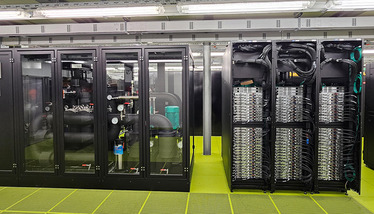Work on KIT's new supercomputer HoreKa 2 began a few weeks ago with the delivery of the first racks. As the successor to the Karlsruhe supercomputer (HoreKa), which will go into operation in 2021, the system will provide researchers with additional computing capacity. The aim of this new computing cluster is to meet the constantly growing demands for computing power and data processing in science.
The new infrastructure relies on modern, highly efficient components to ensure maximum performance with optimum energy efficiency.
- Lenovo SD665 V3 systems with the latest "AMD Turin" technology are used in the CPU partition. All components are supplied by a complete warm water cooling system, which enables maximum density and efficiency.
- The GPU partition is based on the Lenovo ThinkSystem SC777 V4, which combines ARM-based, NVLink-connected NVIDIA Grace CPUs and NVIDIA Blackwell GPUs in one compute tray. This is currently the most powerful platform for GPU and AI applications. Here too, the "Lenovo Neptune" liquid cooling technology ensures complete direct warm water cooling of all components.
- The storage system is built with IBM Storage Scale Systems (SSS 6000) with a two-tier architecture of NVMe and HDD tiers. This NVIDIA-certified high-performance solution forms the basis for HPC and AI infrastructure on NVIDIA Grace Blackwell systems and thus promotes the next generation of data-driven research and innovation.
The management systems are also water-cooled with Lenovo's Neptune Core (OpenLoop) technology, where technically possible, to ensure a consistently sustainable and efficient overall system.
Thanks to numerous water-cooled components, the new supercomputer sets new standards in terms of efficiency and energy consumption. Up to 99% of the heat generated is dissipated directly into the warm water, which enables highly efficient cooling throughout the year. The waste heat generated is used to heat the buildings on site.
The construction of HoreKa 2 is divided into two phases:
Phase I comprises the installation of the storage and CPU units and should be completed by the end of this year. User operation is scheduled to start at the beginning of 2026.
Phase II will see the installation of the GPU units and the transition to full operation with full system performance in the coming year.
In addition to the installation of the new, more powerful system, the computer room will also be extensively modernized. The building constructed in 2016 for the high-performance research computer II will thus be fit for the future.
Contact at SCC: Dr.-Ing. Samuel Braun


